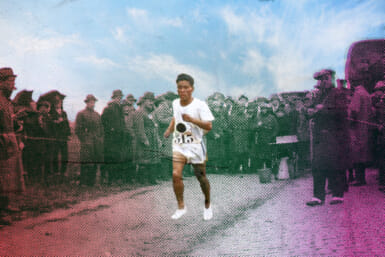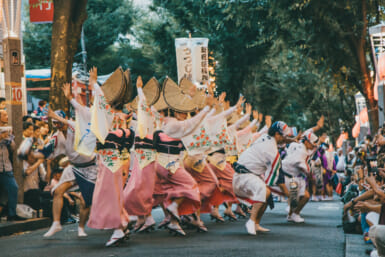by Yurie Horiguchi
The other morning I watched and listened in fascination to the 7:20 a.m. NHK “Camera Report” program.
In lugubrious tones, the reporter commented on the lapse of good manners in Japan while the camera showed a typical Sunday afternoon scene in the “pedestrian paradise” areas of Ginza and Shinjuku.
The reporter’s wrath was incurred by frequent scenes of young and not so young people openly munching hamburgers, hot-dogs, yaki-soba, etc. in the streets, or licking ice-cream cones and drinking milk-shakes while walking up and down, window-shopping.
He kept stopping people to ask, “Don’t you feel ill at ease eating in public? Don’t you feel it is very bad manners?”
Some young girls looked abashed, others said it was “kakko-il” or the “in” thing to do, while a few stared back into the camera and wanted to know what business it was of NHK to ask such questions.
This upset the poor reporter even further, and even the camera gave a faint tremor.
So what is all the pother about, you wonder. The answer is etiquette—Japanese versus Western.
It has, for centuries, been quite infra dig for people to be seen eating while walking in the streets. This is quite extraordinary in a land where men may urinate against walls in public. Why the one and not the other?
My mother used to have a wonderful answer to unanswerable questions. She would merely reply, “Because.” And that shut one up.
Etiquette is not something invented by Emily Post for Americans who believe their standards should prevail throughout the rest of the world. It is a traditional pattern of manners indigenous to each country and to each race on this earth. In short, what is sauce for the goose is not always sauce for the gander.
So while it is perfectly permissable in Japan to eat standing up at an outdoor food-stall (oden, soba or ramen, for example) or while seated, even on a public bench, it was considered totally bad manners to be seen munching food, or fruit, or even a bun or cake, while walking down a street. Even ice-cream cones were (and often still are) eaten on the sidewalk in front of the vendor’s stall.
It is only in the last few years that this has changed, especially among the young, but it still remains shocking to a certain generation of Japanese, to which the aforementioned NHK reporter evidently belonged.
The questions he asked the people interviewed showed his own lack of manners, incidentally. You don’t go up to a complete stranger in any country in the world and say, “Look chum, your manners are deplorable.”
The reporter appeared to be very put out because the people caught eating on camera “don’t even look happy!”
He kept referring to the Ginza and Shinjuku street scenes as “public picnics,” and commented on the lack of festivity in the air. Since the Japanese generally get festive in public only after imbibing several liters of sake (cherry-blossom viewing parties, etc.) it seemed to me that the reporter should have been thankful that the people were only drinking milk-shakes, cokes and the like.
But no, the man was plain miserable.
So then I started thinking of other breaches of etiquette committed, this time, by foreigners in Japan.
Although the latter often and sometimes vociferously lament the Japanese “lack of manners,” it may come as a surprise to them to know that the majority of Japanese—those who have never traveled abroad or come under the influence of the West—consider certain Western ways to be quite offensive.
For instance, the Western caller’s custom of entering a house wearing his/her coat, scarf and gloves is shocking to the Japanese who remove all outdoor garments in the entrance (genkan) before taking off their shoes.
And you may have noticed that a Japanese guest, when leaving, often refuses to put on his coat—no matter how cold it may be until he has stepped outside your door.
When handed a gift, the Westerner usually tears open the package in front of the donor so that the latter may evidence his appreciation. But traditional etiquette does not permit a Japanese to open a gift in the presence of a giver. In a typical Japanese house, it is placed on the tokonoma unopened until the caller has departed.
This tradition is fast dying out, however. Now one usually asks permission of the giver to open his gift in his presence so that it can be generally admired.
Japanese children are taught to blow their nose using both hands cupped over the handkerchief or tissue. They think it very strange to see a foreigner blowing his nose with one hand only.
A lady in kimono removes her shawl and gloves when greeting an acquaintance on the street, even in the coldest of weather, but the Westerner remains bundled up when doing the same. Shocking!
The Japanese have no table manners? They certainly have, even down to the way in which chopsticks should be picked up and taken apart. There are schools of etiquette where proper Japanese table manners are taught to young ladies preparing for marriage.
When a foreigner — or any visitor — is invited to a Japanese home, infinite pains go into the preparation of the meal.
The hostess endeavors not only to produce delicious food but also dishes that are a delight to the eye in shape and color scheme.
Nothing therefore can be more shocking than to see a guest mess each plate up, trying a bit of this and that but finishing nothing.
Rice, when accepted, would be eaten to the last grain. If one wishes a second helping, a mouthful is left in the bottom of the bowl.
When one has finished eating, all lids should be replaced on bowls such as rice and soup bowls, and the chopsticks placed on the small holders in front of each place. Never leave them balanced on an empty plate or dish.
Finally, though etiquette in the West may be the noise you must not swallow your soup with, in the East it is the noise you must swallow your soup with to express appreciation.
Although the Japanese learned so much from Old China, they never really mastered the art of the post-prandial belch. This is part of Chinese etiquette.
When my children were growing up in China they became past-masters at the art of the prolonged burp to properly show their appreciation for a satisfactory meal.
They were astounded when I constantly rebuked them for it when we left China to live in Europe. “Why can’t we belch?” they wanted to know.
“Because.” I replied.








